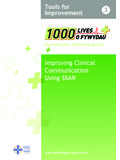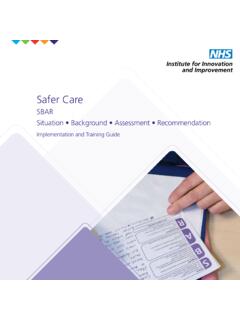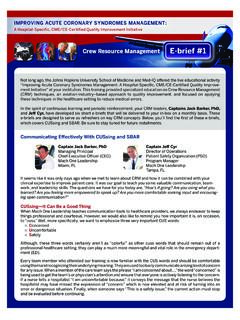Transcription of Patient Safety Solutions | volume 1, solution 3 | May 2007
1 WHO Collaborating Centre for Patient Safety SolutionsAide MemoireS tat e m e n t o f P r o b l e m a n d I mPa c t:During an episode of disease or period of care, a Patient can potentially be treated by a number of health-care practition-ers and specialists in multiple settings, including primary care, specialized outpatient care, emergency care, surgical care, intensive care, and rehabilitation. Additionally, patients will often move between areas of diagnosis, treatment, and care on a regular basis and may encounter three shifts of staff each day introducing a Safety risk to the Patient at each interval.
2 The hand-over (or hand-off) communication between units and between and amongst care teams might not include all the essential information, or information may be misunder-stood. These gaps in communication can cause serious break-downs in the continuity of care, inappropriate treatment, and potential harm to the in communication was the leading root cause of sentinel events reported to the Joint Commission in the United States of America between 1995 and 2006 (1) and one USA malpractice insurance agency s single most common root cause factor leading to claims resulting from Patient transfer (2).
3 Of the 25 000 to 30 000 preventable adverse events that led to permanent disability in Australia, 11% were due to communication issues, in contrast to 6% due to inadequate skill levels of practitioners (3). Hand-over communication relates to the process of passing pa-tient-specific information from one caregiver to another, from one team of caregivers to the next, or from caregivers to the Patient and family for the purpose of ensuring Patient care con-tinuity and Safety (4). Hand-over communication also relates to the transfer of information from one type of health-care or-ganization to another, or from the health-care organization to the Patient s home.
4 Information shared usually consists of the Patient s current condition, recent changes in condition, ongo- c o m m u n i c a t i o n d u r i n g P a t i e n t H a n d -o v e r sing treatment and possible changes or complications that might occur. Patient care hand-overs occur in many settings across the continuum of care, including admission from primary care, phy-sician sign-out to a covering physician, nursing change-of-shift reporting, nursing report on Patient transfer between units or facilities, anaesthesiology reports to post-anaesthesia recovery room staff, emergency department communication with staff at a receiving facility during a Patient s transfer, and discharge of the Patient back home or to another S So cI at e d IS Su eS.
5 Problems with Patient hand-overs are an international con-cern: Australia (5) and the United Kingdom of Great Britain and Northern Ireland (6) have recently reviewed this issue, and developed risk reduction recommendations . While there are at present no best practices for improving hand-over communica-tion, various strategies have been implemented and are being studied. One study of physician hand-overs concluded that pre-cise, unambiguous, face-to-face communication was the best way to ensure effective hand-overs (7). However, experts in the field of Patient Safety agree that Solutions involving the redesign of systems of care delivery will be the most effective in improv-ing hand-over communication (8).
6 Improved system design will enhance the ability of providers to communicate effectively by taking advantage of knowledge about human factors (how hu-man beings make errors), building redundancies into the proc-esses of care, creating forcing functions, and reducing the steps in the processes and thus reducing the opportunities for part, hand-over problems are rooted in the way that health-care providers are educated or not educated (in team training and communication skills), lack of good role models, and a health-care system that promotes and Patient Safety Solutions | volume 1, solution 3 | May 2007rewards autonomy and individual performance.
7 The culture of medicine, which historically has not placed significant emphasis on involving patients and families in the delivery of care, is another root cause. In addition, while speciali-zation of health-care practitioners can improve medical treatment, specialization of care also means more people and units are involved in the Patient s care, which can com-plicate communication. Another problem contributing to poor communication is that staff composition may not re-flect the demographics of the community being served (9). Also, language problems resulting from a heavy reliance on health-care professionals from other countries can also lead to communication difficulties.
8 Lessons on how to improve hand-overs are being learned from other high-risk industries such the aviation and nu-clear power industries. One such lesson is the need for a common language for communicating critical information. Incorporating situational briefing techniques such as the SBAR ( situation , background , assessment , and Recommendation) process can provide a standard communication framework for Patient care hand-overs (10-11). Simply providing op-portunities for providers of care to ask and resolve questions can improve the effectiveness of hand-over communications (12).
9 Streamlining and standardizing change-of-shift report-ing can enhance critical thinking, as well as minimize time spent away from the Patient (13). Read-back is another ef-fective technique used in hand-overs, where the receiver of information writes down the information and then reads it back to the provider of the information to obtain confir-mation that it was understood correctly. Technologies such as electronic Patient sign-outs have been shown to reduce preventable adverse event rates (14). Collaborative (multi-disciplinary) rounds are being used effectively to improve communication and hand-over of important information re-lating to the Patient s care (15).
10 Involving patients and families in the process of care is in-creasingly being recognized as an important aspect of care delivery. The Patient and family are the only constant and are thus in a position to play a critical role in ensuring con-tinuity of care (16). Hospital discharge is a critical stage where communicating information to patients and families becomes vital (17-19). Engaging patients is sometimes made more difficult due to low health literacy. The term health literacy has been defined as the capacity of individuals to obtain, process and understand the basic health information and services needed to make appropriate health decisions (20).


















